![]()
![]()
![]()
Use LEFT and RIGHT arrow keys to navigate between flashcards;
Use UP and DOWN arrow keys to flip the card;
H to show hint;
A reads text to speech;
79 Cards in this Set
- Front
- Back
|
Business Responsibility |
Voluntarily assuming accountability for social, environmental and economic stakeholder issues in order to optimize stakeholder value. (stakeholders include customers, employees, investors, suppliers, communities in which the business operates, etc.) |
|
|
Assessing Corporate Social Performance (CSP) |
Umbrella term used to assess the qualitative and quantitative methods used to evaluate the degree of responsibility assumed by a company 4 Dimensions: 1. Responsibility Category 2. Stakeholder Responsiveness 3. Issues Maturity 4. Organizational Implementation |
|
|
Responsibility Category |

|
|
|
Stakeholder Responsiveness (RDAP) |
How does the company respond to stakeholder claims? 1. Reactive – Deny validity of stakeholder claims 2. Defensive – Accepts claims but avoids responsibility 3. Accommodative – Accepts claims and acts on responsibility 4. Proactive – Anticipate claims and act on them before expressed |
|
|
Issues Maturity |
How well established are the issues to which the company is responding? 1. Institutionalized – More or less expected of them(ex. avoiding human rights violations) 2. Consolidating – Common business practice(ex. reporting carbon emissions) 3. Emerging – Only basic awareness among others(ex. living wage) 4. Latent – Issues yet to reach public awareness |
|
|
Organizational Implementation |
How deeply embedded are the company’s stakeholder responsibilities in organizational processes and structures? (ex. consumers)
1. Isolated – Weakly integrated to processes (ex. buying participation with a consumer review site - BBB) 2. Managerial – Integrated into core processes (ex. assigning responsibility of managing consumer reviews to someone) 3. Strategic – Integrated into strategic planning (ex. identifies plan to create practices that uphold image) 4. Civic – Inspires others to also pursue practices (ex. new initiatives become best practice among industry) |
|
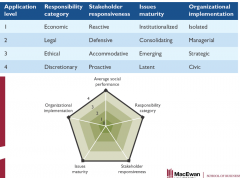
|
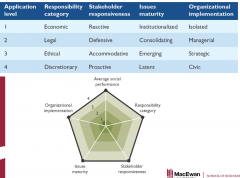
|
|
|
Business Ethics |
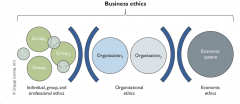
The interdisciplinary study of ethical issues and opportunities in business |
|
|
Ethical Decision-Making Model |

|
|
|
The Fudge Factor
|
humans have a desire to secure the benefits of cheating but simultaneously view ourselves as honest people |
|
|
Sustainability
|
"Meets the needs of the present, without compromising the needs of future generations." - Bruntland Report Triple Bottom Line Intergenerational Justice |
|
|
Triple Bottom Line Performance |
1. Economic Impact – revenues, profit, % of local supplies sourced 2. Social Impact – donations, customer satisfaction, charity promotion, democratic decision-making process 3. Environmental Impact – % of supplies bought from environmentally-friendly materials, reduce waste and responsible disposal |
|
|
Three Dimensions of Sustainable Development |

|
|
|
Interpreting Sustainability (fragmentation vs. holism) |
1. Fragmentation: everyone works in their own disciplines (ex: economists and ecologists) 2. Holism: people work together to achieve results |
|
|
Interpreting Sustainability (substitution vs. complementation) |
1. Substitution: the destruction of one form of capital (ex. trees) can be substituted with another form of capital (ex. technology) 2. Complementation: all three components (economic, social and environment) are mutually reinforcing and important. |
|
|
Interpreting Sustainability (status quo vs. change) |
1. Status Quo: incremental changes and simple increases in efficiency will achieve sustainable development (ex. tackling climate change) 2. Change: existing systems are inept and advocates for drastic systemic changes. |
|
|
Interpreting Sustainability (masters vs. equals) |
1. Masters: “the world is made for man, not man for the world.” – Francis Bacon 2. Equals: natural objects such as animals, forests and ecosystems have right of their own and be treated with responsibility and respect, similar to the way we treat other human beings. |
|
|
Kuznets Curve |
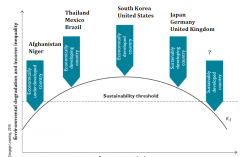
The relationship between economic development and wealth inequalities (inverted U) |
|
|
Sustainable vs Economic Development |
Kuznets Curve:
1. Economically underdeveloped countries – little inequality, homogeneously poor, low levels of consumption minimizes environmental impact 2. Economically developing countries – increase inequality, economic opportunities seized by a minority causing exploitation of natural capital 3. Economically developed countries – decrease inequality through middle class (ex. equitable wages, social benefits), more eco-efficient production decreases negative environmental impact |
|
|
Marketing |
Process that organizations use to design, develop and communicate the value of their products, services or ideas
Customers don’t buy products or services – they buy solutions to problems |
|
|
Values of Marketing |
1. Utilitarian value – functional benefits 2. Hedonic value – emotional benefits |
|
|
Stakeholder Goodwill |
Positive attitude toward an organization among stakeholders (ex. Trust, Credibility, Willingness To Pay)
Integrated Marketing Communications:
1. Consistent approach to internal and external communications, using the marketing mix
2. Can build stakeholder goodwill… for good or bad? |
|
|
The 4 P's |
1. Product 2. Price 3. Place 4. Promotion |
|
|
Communication Process |
Sender: person with whom the message originates
Receiver: person who originally receives the message
Message: unique combination of words and symbols (tone and style) |
|
|
Communication Process Graph (Simple) |
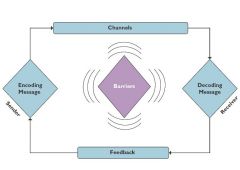
|
|
|
Communication Process Graph (Extensive) |
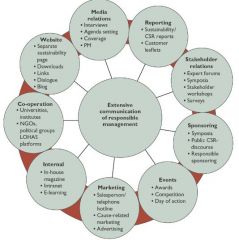
|
|
|
Greenwashing |
misleading impression... appearing more environmental than it really is (ex: VW TDI) |
|
|
Accounting Concept Graph |
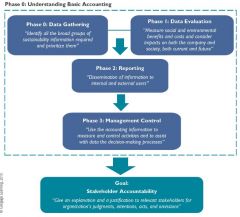
|
|
|
Stakeholder Accountability |
Providing relevant information to stakeholders that allows them to hold the organization accountable for its activity and outcomes.
Can only report on activity that is measured and managed.
Stakeholders include internal and external ones, despite prevailing approach of financial data to support economic decision making for shareholders. |
|
|
Basics of Accounting |
Data used must be relevant, reliable and comparable
(Can you compare the economic output of a restaurant with that of the Canadian BloodServices?) |
|
|
Types of Accounting |
1. Financial (external)- Balance Sheet, Income Statement, Retained Earnings
2. Management (internal)- bookkeeping, budgeting, net present value |
|
|
Ethics of Accounting |
Obligation to the public, profession and organization |
|
|
Main Drivers for Sustainability Accounting |
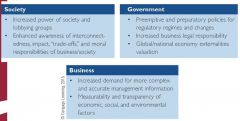
Accounting of social, environmental and economic impacts Distinctive key factors include: 1. Focus on ethical, social and environmental data
2. Not just shareholders, but wide range of stakeholders
3. Voluntary, not yet regulated by law |
|
|
Communicating ESG |
Description of non-financial data (environment, social and governance)
Materiality: shared importance of a specific issue to both company and stakeholders
1. Evidence of interest
2. Evidence of economic impact
3. Forward-looking adjustment (emerging issues) |
|
|
Responsible Financial Management Process |

|
|
|
Short-run profit maximization can lead to unsustainable (disastrous) results |
Short-run profit maximization can lead to unsustainable (disastrous) results |
|
|
Criticized Paradigms of Financial Management |
1. Profit
2. Growth
3. Short-Run
4. Money
5. Shareholder
6. Internality |
|
|
Socially Responsible Investing |
Involves screening activities (social, environmental and ethical questions) in the selection of financial products Positive vs negative screening DJSI and other indices represent significant capital investments upon entering index |
|
|
Alternative Financing/Ownership Models |
1. Impact Investing – balancing economic withsocial/environmental returns 2. Crowdfunding – external funding from a large audience
3. Cooperatives – owned and run by its members
4. Cross-Financing – one area pays for another (i.e., a nonprofit running a social enterprise)
5. Goodwill Financing – leveraging goodwill image to generate revenue (i.e., CRM, subsidies for sustainability activities)
6. Debt Financing – includes traditional as well as microfinance |
|
|
Operations Management |
Concerned with design and management of products, processes, services, systems and supply chains. Acquisition, development and use of resources needed to deliver services, information and goods.
Examples: 1. Strategic – determining facility location/size 2. Tactical – facility layout, equipment selection 3. Operational – materials handling and transportation |
|
|
Responsible Operations Process |
Activities that help transform inputs to outputs Analyzes effectiveness and efficiency Management System 1. Handles topics across all processes of the company 2. Consists of an entire set of organizational documents 3. Involves continual improvement mechanisms (internal andexternal audits) |
|
|
Supply Chain |
Series of interconnected value-creating (production) and value-depleting (consumption) activities from the first raw material to the final consumer.
Responsible Supply Chain: optimizes the TBL, stakeholder value and ethical performance throughout supply chain. |
|
|
4 SME Tips for Responsible SC Changes |
1. ensure that responsible business is understood internally, and that it is translated to principles and values for day-to-day management
2. find a “champion” and identify the low-hanging fruit activity
3. make responsible business activity highly relevant to employee’s jobs and business success
4. identify how this is a win-win, creating social value as well as economic value |
|
|
International Business |
Global, International, Multinational, Foreignbusiness activities… anything but domestic |
|
|
What is Globalization and “Glocalization”? |
Globalization “refers to the widening set of interdependent relationships among people from different parts of the world”
Glocalization is a mixture of the words “global” and “local” and describes global activities with a strong adaptation to local circumstances. |
|
|
Drivers and Challenges of Globalization |
1. Global Media
2. Global Communication Technologyand Access to Internet
3. Global Transportation
4. Emergence of Global Standards
5. The Rise of BRICs
6. Anti-Globalization Movements and Global NGOs
7. Global Challenges and Opportunities |
|
|
Global Trade: Pro-Trade |
Potential to...
1. reduce economic inequalities
2. create a truly inclusive global economic system |
|
|
Global Trade: Contra-Trade |
has been widely criticizedfor many of the ailments ofthe global economicsystem |
|
|
Why Do Companies Go International? |
Markets 1. Similar customer needs (e.g. credit cards) 2. Global customers (e.g. carcomponents) 3. Transferable marketing (e.g. Coca-Cola)
Costs 1. Volume reduces costs 2. Country-specific differences (e.g. clothing: manufacturing in Bangladesh/design in France) 3. Favourable logistics (e.g. lowcost of transporting microchips) |
|
|
Global Sourcing |
the process of procuring inputs used throughout the supply chain internationally
1. Outsourcing: third-party company provides a needed service or process
2. Offshoring: activities that were done domestically are now carried out abroad
3. BoP Sourcing: sourcing activities involving small and medium enterprises at the base of the pyramid |
|
|
Foreign Subsidiaries and Global Alliances |
International subsidiaries are business units located inforeign countries
Foreign Direct Investment (FDI) is a measure of foreign ownership consisting of financial investmentsand tangible or intangible assets transferred abroad |
|
|
Global Trade (4 responsible types) |
1. Responsible trade: practices that mitigate the potential negative impacts oftrade and harnesses the potential of trade to do good.
2. Sustainable trade: refers to trade as a tool to further sustainable development, socially, environmentally, andeconomically.
3. Ethical trade: aims to assure the avoidance of ethical issues in global supply chains.
4. Fair trade: is a trading partnership, based on dialogue, transparency and respect, that seeks greater equity ininternational trade. |
|
|
Stages of Global Business Responsibility |
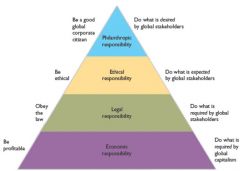
|
|
|
What is Business? |
Organizations that are designed to achieve a specific goal
Businesses are organizations, typically with a financial goal (i.e., profit). They can also have a social and/or environmental goal, and are often nonprofits (or social enterprises)
They use Assets, Labour, Capital and Managerial Acumen to form its business model and articulate its value proposition (which should represent their competitive advantage)
Benefits: service, product, brand, cost, emotional
Competitive Advantage: enduring quality that competitors can not replicate easily that has value - generate more sales - greater margins - achieve a lower cost base - attract and retain more customers/employees |
|
|
Business Objectives |
Profit (short-term) vs. Profitability (long-term)
Social and environmental responsibility |
|
|
Issues and Actors of Responsible Management |
1. Sustainability: related to the triple bottom line; threatens the survival of current and future generations
2. Responsibility: nature of relationships between stakeholders
3. Ethics: decision making in ethical dilemmas (wrong vs. right) |
|
|
Issues and Actors of Responsible Management: Government Responsible Management |
Positives: legislation, public policies, infrastructure Negatives: restricted geography, slow decisions |
|
|
Issues and Actors of Responsible Management: Civil Society |
Positives: voting power – political / economic (consumer) votes
Negatives: poorly coordinated, disjointed |
|
|
Issues and Actors of Responsible Management: Business |
Positives: broad activities and geographic reach, fast decisions
Negatives: restricted to profitable activities |
|
|
Milton Friedman on Corporations |
a corporation’s sole obligation is to maximize wealth to its shareholders and has no responsibility or capability to address society’s interests |
|
|
Responsible Management |
Responsibility over:
1. embracing the TBL (sustainability)
2. optimizing stakeholder value (responsibility)
3. creating moral excellence (ethics) |
|
|
3 Components of Management |
1. Inputs: resources and goals 2. Process: effectiveness (degree to which process contributes to managerial goals) and efficiency (ratio between inputs over outputs) 3. Outputs: performance |
|
|
Evolution of Management Thought |
1. Must serve a higher purpose, to achieve noble, socially significant goals.
2. Fully embed ideas of community and citizenship.
3. Reconstruct management’s philosophical foundations… not enough to be merely efficient. Be more interdisciplinary (draw from biology, political science and theology). |
|
|
Management Process of an Organization |
1. Planning – making decisions about future goals and activities
2. Organizing – building the structure, systems and culture needed to implement a strategy (Mechanistic versus Organic)
3. Leading – influencing others to attain goals through various forms of power (legitimate, coercive, reward, referent, expert)
4. Controlling – assessing and steering activities based on performance measurement |
|
|
Management Skills / Levels |
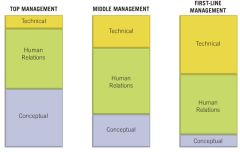
|
|
|
Organizational and Management Theory |
the design and evolution of social structures within modern organizations |
|
|
The Process of Creating a Responsible Organization |

|
|
|
Opposing Views on Organizations |
Individualism vs. Collectivism
Realism vs. Constructivism
Instrumentalism vs. Institutionalism |
|
|
Assumptions and Policies for Organizations |
1. Traditional Model: more control needed
2. Human Relations Model: creates environment for meaningful work
3. Human Resources Model: win-win situations between employees and company (most democratic structure) |
|
|
The Strategic Management Process Purpose |
Crafting and implementing organizational strategies with the goal of achieving sustained competitive advantage… while creating value for society andthe environment. |
|
|
Strategy |
Integrated and coordinated set of commitments and actions designed to gain a competitive advantage. |
|
|
Responsible Competitiveness |

Phase I: Vision, Mission and Objectives
Vision – what the organization aims to become and achieve (future-oriented)
Mission – statement of purpose (present-oriented)
Phase II: Analyzing the Strategic Environment
External: Porter’s Five Forces
Internal: Value Chain Model
SWOT Analysis: 1. Strengths 2. Weaknesses 3. Opportunities 4. Threats |
|
|
Social Entrepreneurship |
Sustainable exploitation of opportunities to create social/environmental benefit
Filled with hybrid structures between for-profit, nonprofit and public organizations… must attend to different mandates.
Value-added ventures:
1. more democratic structures where stakeholders are integrated into ownership, governance and management (internal)
2. a social mission that strives to benefit society (external) |
|
|
Social Entrepreneurship Perspectives |
1. Social Innovation: the entrepreneur is the hero… invents new concepts such as microloans
2. Value Proposition and Social Mission: creating social value is the core of achieving a social mission
3. Socialized Ownership and Control: democratic frameworks encourages reciprocity between all members |
|
|
Human Resource Management |
the impact of HR decisions on internal outcomesrelated to efficiency and economic growth.
1. staffing, employment and recruitment
2. training and development
3. benefits
Responsible HRM integrates the impact ofoutcomes on people, society and the environment. |
|
|
The Normative Perspective on HRM |
Hard HRM: job analysis, recruitment, compensation and benefits, performance evaluations, contract negotiations, labor legislations (employee serves organization)
Soft HRM: organizational development, conflict management, leadership development, organizational culture, relationship building, trust building (employee and organization share goals) |
|
|
HR-RM Symbiosis |
- Employees need to be engaged, in order to conduct business responsibly
- Responsible business helps employees feel more engaged
- Example: employees reducing their paper usage helps the business be eco-friendly, while being eco-friendly helps employees feel more motivated to reduce paper use/saves on coststhat can lead to improved employee benefits |
|
|
Responsible HR Practices and Skills |
Practices:
1. Going green 2. Advancing diversity 3. Employee well-being 4. Human rights
Skills:
1. Communication (with stakeholders/employees) |
|
|
Responsible Workplace Practices: RESPECT Model |
important things you want from the organization you work for. - Recognition - Excitement - SecurityPay (only 25% of people wanted this) - Education - Conditions at work (social and physical) - Truth |

